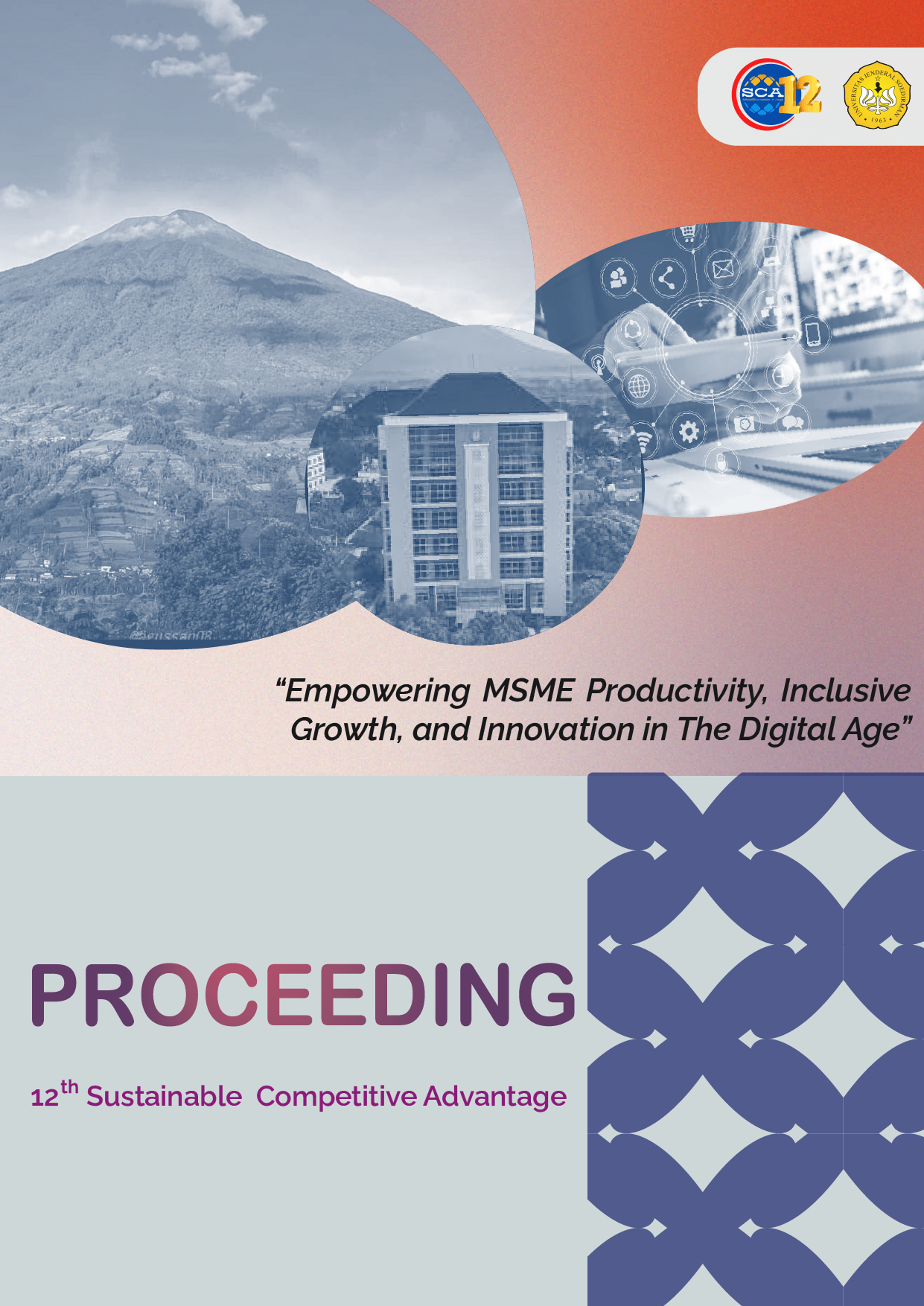The Factors On Mobile Banking-Based Application User Satisfaction And Personal Finance As Intervening Variable
Abstract
This study aims to analyze and determine how much perceived usefulness, service quality, and quality of Self-Service Technology mobile banking-based applications influence user satisfaction and personal finance during the Covid-19 pandemic in South Tangerang City. The method used in this study is a quantitative method using primary data obtained from distributing questionnaires. The sampling technique used is purposive sampling with a sample size of 200 respondents. The data analysis method in this study uses the Structural Equation Model (SEM) with SmartPLS 3.0. These results indicate that perceived usefulness, service quality, and quality of Self-Service Technology positively affect user satisfaction and personal finance.
Keywords: Perceived Usefulness, Service Quality, Quality of Self-Service Technology, User Satisfaction, Personal Finance, Mobile Banking
References
Amin, S., Tripathi, A., Kansana, K., & Malik, J. (2019). Understanding Self-Service Technologies INTRODUCTION TO SERVICES. Management in Practice, 136–145.
Antonio, G. C., Intan, R., Adipranata, R., Informatika, P. S., Industri, F. T., Petra, U. K., & Surabaya, J. S. (2021). Pengelolaan Keuangan Pribadi yang Interaktif Berbasis Android. Jurnal Infra, 9(2).
Arcand, M., PromTep, S., Brun, I., & Rajaobelina, L. (2017). Mobile banking service quality and customer relationships. International Journal of Bank Marketing, 35(7). https://doi.org/10.1108/IJBM-10-2015-0150
Ashsifa, I. (2020). Pengaruh Technology Acceptance Model (Tam) Terhadap Kepuasan Pelanggan Dan Niat Penggunaan Mobile Banking Secara Berkelanjutan (Privasi Dan Personalisasi Sebagai Variabel Moderasi). TECHNOBIZ Journal, 3(1), 25–29.
Azisyah, D. A. (2016). PENGARUH SELF SERVICE TECHNOLOGY, KUALITAS LAYANAN, HUBUNGAN PEMASARAN TERHADAP KEPUASAN DAN LOYALITAS NASABAH PADA BANK BNI DI SURABAYA. Manajemen Perbankan, 66, 37–39.
Davis, F. D. (1989). Perceived usefulness, perceived ease of use, and user acceptance of
information technology. MIS Quarterly: Management Information Systems, 13(3). https://doi.org/10.2307/249008
De Leon, M. V., Atienza, R. P., & Susilo, D. (2020). Influence of self-service technology (SST)
service quality dimensions as a second-order factor on perceived value and customer
satisfaction in a mobile banking application. Cogent Business and Management, 7(1). https://doi.org/10.1080/23311975.2020.1794241
Fernando, E., Surjandy, S., Meyliana, M., Wijadja, H. A., Hidayat, D., Kusumaningtyas, A. W., & Heryatno, R. (2020). Factors influencing the intention to use technology services to implement self-service technology case study: Situation pandemic Covid-19. Advances in Science, Technology and Engineering Systems, 5(5). https://doi.org/10.25046/AJ050542
Hair, J., Black, W., Barry, J., Anderson, R., & Tatham, R. (2006). Multivariate data analysis. Pearson. Prentice hall. Upper Saddle River.
Hosseini, Mirza and Fatemifar, Azadeh and Rahimzadeh, Masoumeh, (February 2015), Effective Factors of the Adoption of Mobile Banking Services by Customers, VOL - 4, DOI 10.12816/0018964, Kuwait Chapter of Arabian Journal of Business and Management Review.
Inayah, N., Agriyanto, R., & Warno, W. (2018). The Role of Spirituality in the Behavior of Sharia Bank Mobile Banking: Evidence from Indonesia. Walisongo: Jurnal Penelitian Sosial Keagamaan, 26(1), 197. https://doi.org/10.21580/ws.26.1.2611
Kotler, P., & Keller, K. L. (2016). Marketing Mangement. In Pearson Edition Limited.
Latan, H., & Ghozali, I. (2015). Partial Least Saquares Konsep , Teknik dan Aplikasi Menggunakan Program SmartPLS 3.0 Untuk Penelitian Empiris :Universitas Diponegoro. Universitas Diponegoro.
Lin, J. S. C., & Hsieh, P. L. (2011). Assessing the Self-service Technology Encounters:
Development and Validation of SSTQUAL Scale. Journal of Retailing, 87(2). https://doi.org/10.1016/j.jretai.2011.02.006
Nawangsari, S., & Widiastuti, R. (2018). Analisis Pengaruh Kualitas Layanan, Kepercayaan Dan Layanan Mobile Banking Terhadap Kepuasan Nasabah Bank (Studi Kasus Pada Pt Bank Dki – Depok). Sebatik, 22(2), 51–55. https://doi.org/10.46984/sebatik.v22i2.307
Priantinah, D., Aisyah, M. N., & Nurim, Y. (2019). The Analysis of Technology Acceptance Model (TAM) For Personal Financial Management On Mobile Application Technology. January.
https://doi.org/10.2991/icobame-18.2019.56
Qian, W. X. (2019). Faculty of Business Determinants and Consequences of the Use of
DigitalFinance Platform for Personal Financial Management in Rural China. April.
Romney, M. B., Steinbart, P. J., Summers, S. L., & Wood, D. A. (2021). Accounting Information
Systems. In Education and Linguistics Research (15 ed.). Pearson Education. https://doi.org/10.5296/elr.v4i2.14045
Saal, M., Starnes, S., & Rehermann, T. (2017). Digital Financial Services: Challenges and Opportunities for Emerging Market Banks. Digital Financial Services: Challenges and Opportunities for Emerging Market Banks, 42. https://doi.org/10.1596/30368
Setiawan, H. (2016). PENGARUH KUALITAS LAYANAN, PERSEPSI NILAI DAN KEPERCAYAAN TERHADAP KEPUASAN DAN LOYALITAS PENGGUNA
LAYANAN MOBILE BANKING. Jurnal Keuangan dan Perbankan, 20(3), 518–528.
Skagerlund, K., Lind, T., Strömbäck, C., Tinghög, G., & Västfjäll, D. (2018). Financial literacy and the role of numeracy–How individuals’ attitude and affinity with numbers influence
financial literacy. Journal of Behavioral and Experimental Economics , 74. https://doi.org/10.1016/j.socec.2018.03.004
Tam, C., & Oliveira, T. (2017). Literature review of mobile banking and individual performance. In International Journal of Bank Marketing (Vol. 35, Nomor 7). https://doi.org/10.1108/IJBM-09-2015-0143
Toor, A., Hunain, M., Hussain, T., Ali, S., & Shahid, A. (2016). The Impact of E-Banking on Customer Satisfaction: Evidence from Banking Sector of Pakistan. Journal of Business Administration Research, 5(2). https://doi.org/10.5430/jbar.v5n2p27
Warsono. (2010). Prinsip-Prinsip dan Praktik Keuangan Pribadi. Jurnal Ekonomi dan Bisnis, 13(2).
Wicaksono, B. (2015). PENGARUH SELF-SERVICE TECHNOLOGY TERHADAP KEPERCAYAAN, KEPUASAN NASABAH, DAN LOYALITAS NASABAH (Survei Pada Nasabah Pt. Bank Rakyat Indonesia (Persero) Tbk. Kantor Cabang Malang Kawi Kanwil Malang). Jurnal Administrasi Bisnis S1 Universitas Brawijaya, 25(2), 86168.
Wijayanti, D. E. A. dan A. T. dan D. (2021). Analisis Tingkat Kepuasan Nasabah Pengguna. Banking & Management Review, 2015, 1398–1409.

